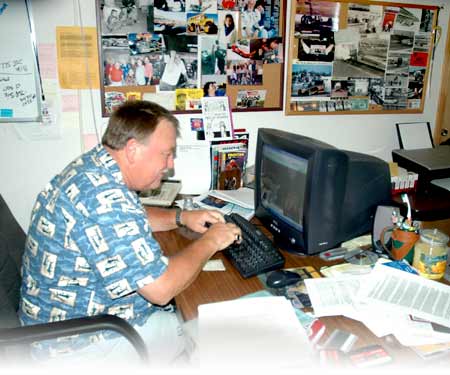
The racers are still smarter than the tech department, or Alley's dilemmas 8/24/05
In my opinion Ray Alley (a nice man that I really like) has been given a task that was doomed to failure from the start. He and his team have been tasked with re-inventing Top Fuel and Funny Cars so that they will be safer, slower and less expensive to build. And by the way, Ray, don't piss off any of the premier teams, tuners, manufacturers, or major sponsors while you're doing this. Yeah, that would be an easy job. The first thing Alley and his team did after Russell's crash was to develop a spec for a safer cockpit design and a stronger wing support among other modifications to the chassis specs. Then they issued rules designed to stop teams from developing and building better and more expensive engine and drivetrain parts. At the same time Alley tasked the engineers at MSD with developing an engine rev-limiter. The company responded in short order by designing, building, and testing a unit compatible with the existing magneto system. Not only that, but MSD also installed and serviced the system for the racers. So, after about 14 months how is Mr. Alley and NHRA's project to slow down the technology race and the money race and also build safer Top Fuel and Funny Cars coming along? If I were asked to give a letter grade for those three subjects, I'd have say on the safety issue the letter grade would be a D! No doubt the cocoon devised for the drivers makes them safer, but more than a year after Russell's crash Tony Schumacher's Top Fueler -- a car from the same builder as Russell's -- broke a bottom frame rail and the car almost came apart in the lights. The NHRA has made changes to strengthen that particular chassis. However they still haven't made head and neck restraint devices mandatory for all classes. As far as slowing down the cars, I have to give that effort an F! It took the crew chief/tuners of the nitro cars all of about two weeks to figure out how to circumvent the rev-limiter. Many of them were happy to show me how it was done, and they found they could do it both mechanically and electronically. The 337+/4.44 speed and ET recorded by Tony Schumacher at Brainerd nearly 14 months after Russell's death speaks for itself. No less an expert than Alan Johnson has said on TV that if the track and atmospheric conditions are right the nitro-burners are going to keep going quicker and faster. On the subject of controlling the cost, the grade would also have to be an F! According to the many team owners and crew chiefs I spoke with at Memphis, the cost just keeps spiraling upward and out of control despite the spec engine/drivetrain program. The teams with major sponsors and virtually no budget constraints just keep developing better parts, buying more of them, adding more payroll, crew, rolling stock, and spares. Lesser-funded teams struggle to afford buying enough new parts from one race to the next to stay competitive. Well-funded teams are able to buy parts in large quantity, making it hard for the second tier teams to get parts even if they can afford them. In the meantime, rule changes keep escalating the cost as all teams have to buy different parts or make changes. One owner at Memphis told me that NHRA is considering a change in the chassis spec that could possibly require all teams to buy new chassis. Another crew chief explained to me that NHRA's new wing rule mandates a maximum/minimum two-degree "down-bubble" spec for the wings. He said that although the intent of the rule was to regulate down-force and the cost of wings, in fact it didn't. "My four-year-old wing wasn't designed to deliver maximum down-force at two degrees," he told me. "In order to get the maximum down-force out of the wing the big teams are ordering $10,000 wings that are designed to be their most efficient at two degrees of down-bubble. They're called 'two-degree optimized.' I can't afford a wing like that, so I'm giving away a couple of hundred pounds of down-force at the minimum to those guys." Another crew chief lamented the fact that the newest iteration of superchargers for nitro cars were now priced at $7500 each and teams needed at least three of them to be competitive. The Pro pits at Memphis were full of racers and crew chiefs hot under the collar and it wasn't the 107-degree heat factor. They were mad because they believed Alan Johnson circumvented the spirit of the rules regarding the rev-limiter and NHRA did nothing to him because he works for a very high-profile team owner. The consensus I got was that the lower profile teams feel that the high profile teams with a major NHRA sponsor or multiple-car teams with multiple major sponsors get more favorable decisions from NHRA and Ray Alley. The facts don't bear that out. In recent times I've seen that teams such as John Force's, Connie Kalitta's, and Greg Anderson's have had the tech department's decisions go against them. Nevertheless, some smaller teams think rules that would slow down the fuel cars and could be easily enforced, such as reduced wing area or reduced blower overdrive, aren't considered because crew chiefs on teams near the top of points program don't want to have to learn a new tune-up which changes such as those proposed above would require. Alley's real dilemma is that he is trying to protect nitro racers whose life's work is to make their race cars go as quick and fast as they can and win. They will work to accomplish that 24/7. Also, despite what they might say, for the most part the drivers are willing to put themselves in harm's way to accomplish that task. History is full of examples of zealots overcoming all odds because they are willing to sacrifice everything. Many Top Fuel owners, drivers and crew chiefs are zealots. It'll take more than one good man to slow them down. |
||||||||||||||||||||||||||||||||||||||||||||||||||


 rom almost the day after Darrell Russell's fatal crash at St. Louis, NHRA's Director of Top Fuel and Funny Car Racing, Ray Alley, has been the lead man in charge of making and enforcing a variety of rules designed, first, to protect the drivers by making the cars inherently safer; second, to stop the escalating top end speeds that have apparently contributed to tire and chassis failure; and, third, to stop the spiraling cost of racing nitro cars by stopping the technology race.
rom almost the day after Darrell Russell's fatal crash at St. Louis, NHRA's Director of Top Fuel and Funny Car Racing, Ray Alley, has been the lead man in charge of making and enforcing a variety of rules designed, first, to protect the drivers by making the cars inherently safer; second, to stop the escalating top end speeds that have apparently contributed to tire and chassis failure; and, third, to stop the spiraling cost of racing nitro cars by stopping the technology race. 
